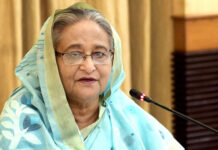ADB publishes Asia-Pacific social protection index

This January 9, 2011 photo shows people crowding at an Open Market Sale point in Lalbagh area in the capital to buy rice and wheat at subsidised price for poor.
Social protection systems in Bangladesh is failing to support large numbers of poor and vulnerable people, leaving them exposed to risks and unexpected difficulties like unemployment, ill health, and natural disasters, according to an Asian Development Bank (ADB) study.
The report, published on the ADB website Wednesday, ranked Bangladesh 28th among 35 countries from Asia and Pacific region based on Social protection Index (SPI).
The SPI is an indicator that divides total expenditures on social protection by the total number of intended beneficiaries of all social protection programs, said the ADB study.
“Three major programmes are taken into consideration when calculating SPI for a given country-social insurance, social assistance and active labour market programmes,” it added.
With the expenditures for social protection less than 3 percent of its GDP in 2009, Bangladesh is among the countries where progress on social protection needs to be accelerated, though its low-income is likely to constrain its ability to mobilise the necessary revenue, it further said.
Most of Bangladesh’s existing social protection programs are focused on the labour market, making up 36 percent of all social protection expenditures.
Its three major programmes, including the largest — Employment Generation for the Ultra-Poor — reach well over 6 million beneficiaries, or about 23 percent of all social protection beneficiaries.
Bangladesh’s expenditure on disaster relief has been a major part of its social assistance system, accounting for 19 percent of social protection spending in 2009, the study stated.
Almost 18 million people (roughly 12 per cent of the population) were beneficiaries of such relief that year, it added.
The study lauded the social pensions program for elderly women, stating: “Evaluations of the gender impact of Bangladesh’s allowances suggest that they have helped increase the access of elderly women to health-care services.”
Introduced in 1998, the program accounts for almost 7 percent of Bangladesh’s total social protection expenditures and covers 21 percent of those aged 60 and older, benefiting 900,000 women in 2009.
However, the SPI results suggest that Bangladesh need to expand its social protection systems and make the impact more equitable — not just for the poor but for a substantial proportion of the nonpoor, but vulnerable members of their population, the study suggested.
Source: The Daily Star









